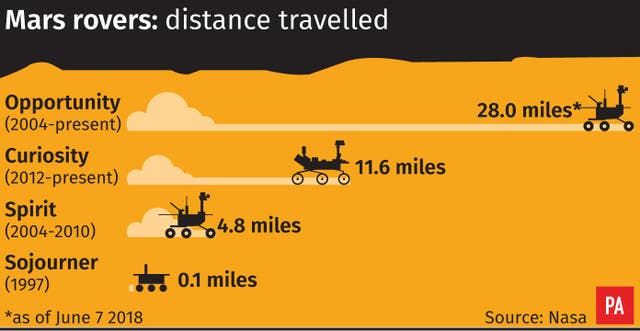Opportunity covered 28 miles on Mars – how does it compare to other spacecraft?
The Mars rover went silent on Sunday after a huge dust storm.

Nasa’s now-silent Mars rover clocked up more than 28 miles as it explored the Red Planet and beamed data back home.
Opportunity, which has been in operation for almost 15 years, is the longest-running Nasa spacecraft on Mars.
But it has not been contactable since Sunday when a huge dust storm engulfed the Red Planet.
Opportunity’s 28-mile route across the Martian surface puts it well ahead of other spacecraft tasked with investigating the planet.

The US space agency launched Opportunity and twin rover Spirit in 2003 to study the Martian surface. The pair landed in 2004.
While Spirit has not worked for several years, Opportunity kept exploring beyond its expected mission lifetime.
It clocked up the distance of 28 miles travelling at a ground speed of 0.11 miles per hour.
Meanwhile, the nuclear-powered Curiosity rover, which landed on Mars in 2012, has recorded 11.6 miles of travel, with a ground speed of 0.08 miles per hour.
Spirit, which stopped working in 2004, managed to cover only 4.8 miles of Martian surface while the Sojourner – which landed in 1997 as part of Nasa’s Pathfinder mission – clocked in just 0.1 miles before becoming defunct shortly after.

Engineers have made repeated efforts to contact Opportunity, but to no avail.
The gigantic dust storm plunged the Red Planet into darkness, cutting off sunlight to the spacecraft’s solar panels.
But the rover might add to its mileage yet.
Officials are hopeful the rover will survive the storm, although it could be weeks – or even months – until the sky clears enough for sunlight to reach and recharge Opportunity’s batteries.

Dust storms crop up every so often on Mars, sending dust into the atmosphere.
But Nasa officials say there is no chance of Opportunity being buried or getting a wheel stuck in dust, and added that the Curiosity rover, which is in Gale Crater, should be fine.
This isn’t Opportunity’s first major brush with dust – in 2007, a massive dust storm kept the rover silent for a few days. The rover jumped back into action soon after.
The next Nasa arrival on Mars is the Mars Rover 2020, which will launch on top of an Atlas V rocket in July 2020 and is expected to land on Mars in February 2021.





